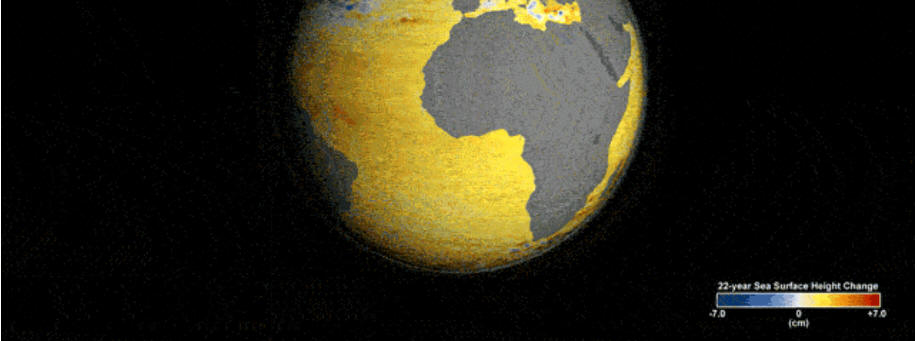Year by year, millimeter by millimeter, the seas are rising. Fed by melting glaciers and ice sheets, and swollen by thermal expansion of water as the planet warms, the world's oceans now on average are about eight inches higher than a century ago. And this sea change is only getting started.
The question is: How much higher will they go?
NASA scientists are now warning that recent projections seem too conservative: Since 1992, sea levels have increased by an average of 3 inches around the world. Three years ago, the Intergovernmental Panel on Climate Change reported that by 2100 sea levels could rise 28 to 98 centimeters (11 to 38 inches), depending on the volumes of greenhouse gases emitted.
Even if greenhouse gas emissions are stabilized and global warming is limited to no more than 2° C, the oceans could reach levels that would transform the world's coasts in the centuries ahead, NASA scientists say.
“With future warming, we may lock ourselves into multiple-meter sea level rise” over the coming centuries, says Eric Rignot, a glaciologist at NASA's Jet Propulsion Laboratory in Pasadena, California. “We're talking about 6 meters—18 feet—and higher of sea level rise. Sea level rise might rise half a meter per century, or several meters per century. We just don't know.”
The IPCC didn't include melting land ice in its sea level projections, and the NASA scientists said Wednesday that the question of how much and how fast the ice will melt is the biggest unknown.
“We have a different picture than we had in 2012 when the last IPCC assessment came out,” says Steve Nerem, an aerospace engineer at the University of Colorado, Boulder. “Sea levels are rising faster than they were 50 years ago, and it's very likely to get worse in the future. The biggest uncertainty in predicting future sea level rises is determining how quickly the polar ice sheets will melt in response to warming.”
Of the world's ten largest cities, eight are located on coasts. Over the next century and beyond, rising seas will threaten Tokyo, New York, Shanghai, Mumbai, and other megacities.
Scientists have deployed a wide range of instruments to study the problem, including airborne radar systems capable of detecting changes in elevation as thin as a dime from 40,000 feet.
On Wednesday, NASA released a computer graphics visualization based on 22 years of satellite data. Although sea levels have risen by an average of 3 inches in the past two decades, complex currents and other natural fluctuations have caused them to fall in some regions, particularly along the west coast of the United States. Over the next decade that trend will probably reverse, and seas on the Pacific coast may rise faster than the global average, the scientists say.
Just how much faster depends on what happens to the world's land ice. But many of the dynamics that govern the evolution of glaciers and ice sheets remain hidden beneath thousands of feet of ice. Researchers do not yet know how fast the warmer water might be melting glaciers from below. Last week satellite images revealed that a five-square-mile chunk of ice had split from the massive Jakobshavn glacier in west Greenland. The Jakobshavn glacier alone contains enough ice to raise global sea levels by more than a foot.
“We've never seen anything on that scale before,” says Rignot. “I was in awe.” The giant calving event shows that ice loss is not always—or even typically—a gradual process. “The IPCC projections produce conservative scenarios of ice-sheet decay, because those models do not yet include the fast melt [of ice] into the ocean that would prevail during times of rapid or catastrophic ice sheet retreat,” says Rignot.
One researcher described a new five-year project that will explore one of the biggest unknowns in climate science: How fast is the Greenland ice sheet melting?
Josh Willis, a JPL oceanographer who is leading the project, said the new NASA mission may help scientists better understand what happens when warm ocean water laps against the bottoms of Greenland's glaciers. The mission is called Oceans Melting Greenland, or OMG. “I picked that name while I was deleting old texts off my cell phone,” says Willis.
The first phase of OMG started this summer, when a refitted fishing boat used sonar to map the undersea canyons carved by ancient glaciers along a fjord in western Greenland. Scientists believe the canyons funnel warm water to the base of glaciers. Next year, two specially equipped NASA Gulfstream jets will begin a five-year mission using radar to map more than 90 percent of Greenland's coast. The map will provide the most accurate record to date of the annual retreat of the ice sheet's glaciers. The aircraft will also drop 250 expendable probes that will measure the temperature and salinity at the edge of the ice sheet to depths of 3,000 feet.

